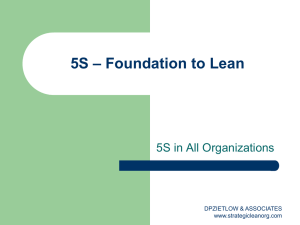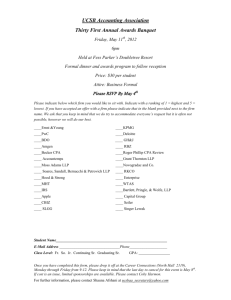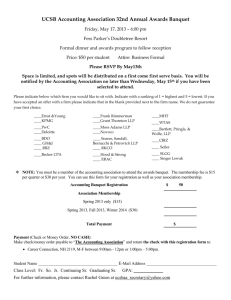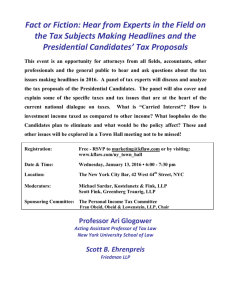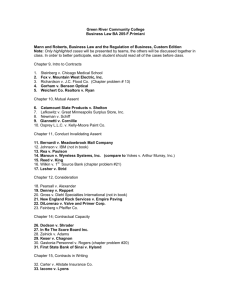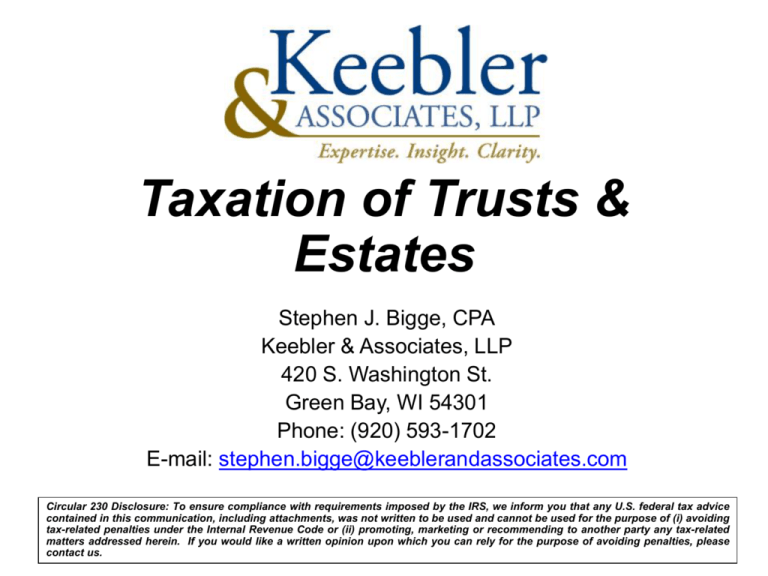
Taxation of Trusts &
Estates
Stephen J. Bigge, CPA
Keebler & Associates, LLP
420 S. Washington St.
Green Bay, WI 54301
Phone: (920) 593-1702
E-mail: stephen.bigge@keeblerandassociates.com
Circular 230 Disclosure: To ensure compliance with requirements imposed by the IRS, we inform you that any U.S. federal tax advice
contained in this communication, including attachments, was not written to be used and cannot be used for the purpose of (i) avoiding
tax-related penalties under the Internal Revenue Code or (ii) promoting, marketing or recommending to another party any tax-related
matters addressed herein. If you would like a written opinion upon which you can rely for the purpose of avoiding penalties, please
contact us.
Taxation of Trusts & Estates
• Foundational concepts
• Tax-sensitive planning
© 2015 Keebler & Associates, LLP
All Rights Reserved
2
Foundational
Concepts
© 2015 Keebler & Associates, LLP
All Rights Reserved
3
Foundational Concepts
Overview
•
•
•
•
•
•
•
•
•
•
•
General tax rules
Types of trusts
Types of income
Distributable Net Income (DNI)
Tier rules
Separate share rule
65-day rule (IRC §663(b))
Charitable deductions (IRC §642(c))
Income in Respect of a Decedent (IRD)
3.8% Net Investment Income Tax (NIIT)
Other issues
© 2015 Keebler & Associates, LLP
All Rights Reserved
4
Foundational Concepts
General Tax Rules
• Trusts and estates are separate taxable entities
– Receive income and pay expenses
• Taxable income computed similar to individuals
– Exemption
○
○
○
$100 complex trust
$300 simple trust
$600 estate
• Method of tax accounting
– Trusts – Calendar year (i.e. Jan. 1st – Dec. 31st)
– Estates – Fiscal or calendar year
© 2015 Keebler & Associates, LLP
All Rights Reserved
5
Foundational Concepts
General Tax Rules
• Income taxed to either the trust/estate or the
beneficiary
– If income is accumulated, then the income is taxed to the
trust/estate
– If income is distributed, then the trust/estate gets an income
tax deduction and beneficiaries report taxable income
© 2015 Keebler & Associates, LLP
All Rights Reserved
6
Foundational Concepts
Types of Trusts
• Simple trusts
– Required to distribute accounting income annually
– Cannot make principal distributions
– Cannot make distributions to charity
• Complex trusts
– May accumulate income
– May make either discretionary or mandatory distributions of
income and/or principal
– May make distributions to charity
© 2015 Keebler & Associates, LLP
All Rights Reserved
7
Foundational Concepts
Types of Trusts
• Grantor trusts
– Trust and grantor treated as one taxpayer
– Income taxed to grantor
• Charitable trusts
– Split-interest trusts consisting of an income beneficiary and a
remainder beneficiary
○
Charitable Lead Trust (CLT) – charity is the income beneficiary
○
Charitable Remainder Trust (CRT) – charity is the remainder
beneficiary
− Last for a term of years or life
© 2015 Keebler & Associates, LLP
All Rights Reserved
8
Foundational Concepts
Types of Income
• Fiduciary accounting income
– Governed by state law and the trust instrument
– Determines the amount that may or must pass to the trust’s or
estate’s beneficiaries
• Tax accounting income
– Governed by the federal income tax law
– Determines who is taxed on the income
© 2015 Keebler & Associates, LLP
All Rights Reserved
9
Foundational Concepts
Types of Income
Typical Types of Fiduciary Income
• Interest
– Taxable
– Tax-exempt
• Dividends
• Rents (net of expenses)
• Royalties
© 2015 Keebler & Associates, LLP
All Rights Reserved
10
Foundational Concepts
Types of Income
Typical Types of Fiduciary Principal
•
•
•
•
•
IRA value as of date of death
Increases in asset value (i.e. growth)
Realized long-term capital gain
Realized short-term capital gain
Proceeds from covered call writing
© 2015 Keebler & Associates, LLP
All Rights Reserved
11
Foundational Concepts
Types of Income
Fiduciary Income vs. Taxable Income Example
Assume that a complex trust had the following sources of
income and deductions during the current tax year:
Interest income
Tax-exempt interest income
Dividend income
Rental income
Royalty income
Long-term capital gains
Taxes
Trustee fees
Attorney/accountant fees
© 2015 Keebler & Associates, LLP
All Rights Reserved
$3,000
1,000
6,000
10,000
5,000
15,000
3,000
3,000
1,000
All indirect expenses
12
Foundational Concepts
Types of Income
Fiduciary Income vs. Taxable Income Example (cont.)
Interest income
Tax-exempt interest income
Dividend income
Rental income
Royalty income
Long-term capital gains
Gross income
Less: Taxes
Less: Trustee fees
Less: Attorney/accountant fees
Less: Exemption
Net Income
Fiduciary
Accounting
Income
$
3,000 $
1,000
6,000
10,000
5,000
$
25,000 $
(1,875)
(1,875)
(625)
$
20,625 $
Taxable
Income
3,000
6,000
10,000
5,000
15,000
39,000
(2,925)
(2,925)
(975)
(100)
32,075
NOTE 1: Trust expenses (for fiduciary accounting purposes) were apportioned on a pro-rata basis
between income and principal.
NOTE 2: Under IRC §265, the trust’s deductible expenses (for income tax purposes) must be reduced
for the portion that are allocable to tax-exempt income.
© 2015 Keebler & Associates, LLP
All Rights Reserved
13
Foundational Concepts
Distributable Net Income (DNI)
• Determines the amount of the trust’s or estate’s
income distribution deduction
• Determines how much the beneficiaries must report
as income on their tax returns
• Determines the character (e.g. interest, dividends,
etc.) of the taxable income in beneficiaries’ hands
© 2015 Keebler & Associates, LLP
All Rights Reserved
14
Foundational Concepts
Distributable Net Income (DNI)
Trust/Estate
DNI acts as a ceiling
for purposes of the
allowable deduction
Beneficiary
DNI acts as a ceiling
for the total amount of
income the beneficiary
must report on his/her
tax return
DNI
© 2015 Keebler & Associates, LLP
All Rights Reserved
15
Foundational Concepts
Distributable Net Income (DNI)
Taxable income
+ Income distribution deduction
+ Exemption
+ Net tax-exempt income
+ Capital losses*
< Capital gains* >
< Extraordinary/stock dividends >
= Distributable Net Income (DNI)
* Except in the year of termination
© 2015 Keebler & Associates, LLP
All Rights Reserved
16
Foundational Concepts
Distributable Net Income (DNI)
• Normally, capital gains and losses are trapped at the
trust or estate level
– However, in the year of termination, the capital gain/loss
passes out to the beneficiaries
• Specific bequests do not carry out DNI to the
beneficiaries
– Not taxable to trust/estate or beneficiaries
– Requirements
o Paid at once OR
o Paid in not more than 3 installments
© 2015 Keebler & Associates, LLP
All Rights Reserved
17
Foundational Concepts
Distributable Net Income (DNI)
DNI Example
Assume that a complex trust had the following sources of
income and deductions during the current tax year:
Interest income
Dividend income
Rental income
Long-term capital gains
Taxes
Trustee fees
Attorney/accountant fees
© 2015 Keebler & Associates, LLP
All Rights Reserved
$15,000
10,000
5,000
20,000
2,500
3,500
2,000
18
Foundational Concepts
Distributable Net Income (DNI)
DNI Example (cont.)
© 2015 Keebler & Associates, LLP
All Rights Reserved
Interest income
Dividend income
Rental income
Long-term capital gains
Total Income
Less: Taxes
Less: Trustee fees
Less: Attorney/accountant fees
Adjusted Gross Income (AGI)
Less: Exemption
Taxable Income
$
Taxable Income
Add-In: Exemption
Less: Long-term capital gains
Distributable Net Income (DNI)
$
$
$
$
$
15,000
10,000
5,000
20,000
50,000
(2,500)
(3,500)
(2,000)
42,000
(100)
41,900
41,900
100
(20,000)
22,000
19
Foundational Concepts
Tier Rules
• Apply to estates and complex trusts
• Two tiers
– First tier beneficiary
o Required distribution of income on a current basis
– Second tier beneficiary
o Receives any amount remaining (at the discretion of the
trustee/executor)
© 2015 Keebler & Associates, LLP
All Rights Reserved
20
Foundational Concepts
Tier Rules
Complex
Trust
Discretionary
distributions
of income and/or
principal
© 2015 Keebler & Associates, LLP
All Rights Reserved
Mandatory
distributions
of income
First Tier
Beneficiary
DNI carries out to
this beneficiary first
Second Tier
Beneficiary
DNI carries out to this
beneficiary only to the
extent that income
exceeds the distribution
made to the first tier
beneficiary
21
Foundational Concepts
Separate Share Rules
• Applies to estates and complex trusts
• Treats multiple beneficiaries of an estate or single
trust as if each were the sole beneficiary
• Determines how DNI carries out to each beneficiary
– DNI is computed separately for each share
© 2015 Keebler & Associates, LLP
All Rights Reserved
22
Foundational Concepts
Separate Share Rules
Separate Share Example
Assumptions
•
•
•
•
•
•
Complex trust
Two equal beneficiaries (S & D)
Distributable Net Income (DNI) in 2015 = $30,000
Distributable Net Income (DNI) in 2016 = $10,000
Trust distributes $20,000 to S and $5,000 to D in 2015
Trust distributes $15,000 to D in 2016
© 2015 Keebler & Associates, LLP
All Rights Reserved
23
Foundational Concepts
Separate Share Rules
Separate Share Example (cont.)
2015 Tax Year 2016 Tax Year
Son
Daughter
Trust
Total
© 2015 Keebler & Associates, LLP
All Rights Reserved
$15,000
$0
5,000
5,000
10,000
$30,000
5,000
$10,000
24
Foundational Concepts
65-Day Rule (IRC §663(b))
• Applies to estates and complex trusts
• Allows fiduciary to treat distributions made within 65
days after year-end to be treated as if they were
made as of December 31st of the prior year
– Limited to DNI (reduced by distributions made during the
prior year)
• Election must be made by the due date of the tax
return
– Election is irrevocable
– Annual election
© 2015 Keebler & Associates, LLP
All Rights Reserved
25
Foundational Concepts
65-Day Rule (IRC §663(b))
Distributions for the 2015 tax year
made during this period will be treated
as have been made as of 12/31/2015
(if a timely election is made)
2015
2016
65 days
12/31
© 2015 Keebler & Associates, LLP
All Rights Reserved
26
Foundational Concepts
Charitable Deduction (IRC §642(c))
• Requirements
– Paid from gross income
– Paid pursuant to the governing document
• Must be actually be paid in the current year
– Exception – pre-1969 trusts
• Unlimited in amount
• Taken as a deduction in computing adjusted gross
income (AGI)
© 2015 Keebler & Associates, LLP
All Rights Reserved
27
Foundational Concepts
Income in Respect of a Decedent (IRD)
Income in respect of a decedent (IRD) – is all items of
gross income in respect of a decedent which were not
properly included as taxable income in a tax period
falling on or before a taxpayer’s death and are payable
to his/her estate and/or another beneficiary
© 2015 Keebler & Associates, LLP
All Rights Reserved
28
Foundational Concepts
Income in Respect of a Decedent (IRD)
Types of IRD
• IRAs and other qualified retirement plans
• Unpaid salaries/wages at the time of death
• Dividends and interest earned, but not taxed, prior
to death
• Unrecognized capital gain on an installment note
at the time of the seller’s death
• Net Unrealized Appreciation (NUA) on employer
securities
© 2015 Keebler & Associates, LLP
All Rights Reserved
29
Foundational Concepts
Income in Respect of a Decedent (IRD)
IRC §691(c) Deduction
• To the extent that a decedent’s taxable estate
includes items of IRD and a federal estate tax is
assessed, the estate and/or its beneficiaries are
entitled to an income tax deduction for the estate tax
attributable to IRD
– This deduction is a miscellaneous itemized deduction NOT
subject to the 2% AGI limitation
© 2015 Keebler & Associates, LLP
All Rights Reserved
30
Foundational Concepts
Income in Respect of a Decedent (IRD)
IRC §691(c) Deduction
• The income tax deduction computation for estate
taxed paid on IRD is determined on a “with and
without” basis
– In essence, the total deduction allowed is the difference
between: (a) the estate tax liability with all items of IRD
included in the taxable estate and (b) the estate tax liability
without the IRD included in the taxable estate
© 2015 Keebler & Associates, LLP
All Rights Reserved
31
Foundational Concepts
Income in Respect of a Decedent (IRD)
IRC §691(c) Deduction Example
On July 1, 2015, Jackie passed away leaving the following
assets:
Cash & money market
Accrued interest
Marketable securities (non-qualified)
Accrued interest & dividends
IRA
Primary Residence
Cottage
Personal property
TOTALS
© 2015 Keebler & Associates, LLP
All Rights Reserved
Non-IRD
$
15,000
750,000
350,000
150,000
50,000
$ 1,315,000
IRD
$
100
9,900
1,500,000
$ 1,510,000
32
Foundational Concepts
Income in Respect of a Decedent (IRD)
IRC §691(c) Deduction Example (cont.)
Subsequent to her death, the personal representative
withdrew $50,000 from Jackie’s IRA. Accordingly, the IRC
§691(c) attributable to the $50,000 distribution would be
as follows:
Gross Estate
Less: Exemption
Taxable Estate
With IRD
Without IRD
$ 2,825,000 $ 1,315,000
(2,000,000) (2,000,000)
$ 825,000 $
-
Estate Tax
$ 371,250
Gross IRC §691(c) Deduction
$ 371,250
$
-
(Difference between estate tax with and without IRD)
© 2015 Keebler & Associates, LLP
All Rights Reserved
33
Foundational Concepts
Income in Respect of a Decedent (IRD)
IRC §691(c) Deduction Example (cont.)
IRD
Interest - Cash & money market
Interest & dividends - Brokerage account
IRA
TOTAL
Gross IRA distribution
IRC §691(c) apportionment percentage
IRC §691(c) deduction
© 2015 Keebler & Associates, LLP
All Rights Reserved
$
100
9,900
1,500,000
$ 1,510,000
Allocable
IRC §691(c)
Deduction
$
25
2,434
368,791
$ 371,250
$
(i.e. $368,791/$1,500,000)
50,000
24.586%
$ 12,293
34
Foundational Concepts
3.8% Net Investment Income Tax (NIIT)
1. Undistributed “net investment
income” for such taxable year
3.8% X
the lesser of
OR
2.
The excess (if any) of—
-
© 2015 Keebler & Associates, LLP
All Rights Reserved
“Adjusted Gross Income” (as defined
in Section 67) for such taxable year,
over the dollar amount at which the
highest tax bracket in section 1(e)
begins for such a taxable year
35
Foundational Concepts
3.8% Net Investment Income Tax (NIIT)
Includes:
•
Interest
•
Dividends
•
Annuity Distributions
•
Rents
•
Royalties
•
Income derived from passive
activity
•
Net capital gain derived from
the disposition of property
© 2015 Keebler & Associates, LLP
All Rights Reserved
Does NOT Include:
•
Salary, wages, or bonuses
•
Distributions from IRAs or qualified
plans
•
Any income taken into account for
self-employment tax purposes
•
Gain on the sale of an active
interest in a partnership or S
corporation
•
Items which are otherwise excluded
or exempt from income under the
income tax law, such as interest
from tax-exempt bonds, capital gain
excluded under IRC 121, and
veterans benefits
36
Foundational Concepts
3.8% Net Investment Income Tax (NIIT)
Mary Ann – Deceased
• Estate/Trust
• $0 employment income
• Undistributed $225,000
net investment income
3.8% NIIT
would apply
to
$213,050
Excess of:
MAGI
$ 225,000
Threshold $ 11,950
Subtotal
$213,050
© 2015 Keebler & Associates, LLP
All Rights Reserved
37
Foundational Concepts
3.8% Net Investment Income Tax (NIIT)
Jerry – Deceased
• Estate
• $100,000 salary (IRD)
• $0 net investment income
3.8% NIIT
would not
apply
Wages are not
subject to NIIT
© 2015 Keebler & Associates, LLP
All Rights Reserved
38
Foundational Concepts
3.8% Net Investment Income Tax (NIIT)
Anita Jones Trust
• $100,000 investment
income
• $50,000 of IRA Income
• A distribution of $90,000
or 60% of AGI
• DNI Reduction of
$60,000
• $40,000 is trapped and
subject to NIIT
© 2015 Keebler & Associates, LLP
All Rights Reserved
3.8% NIIT
would apply
Residual taxable
to the trust, but
potentially to the
beneficiaries
39
Foundational Concepts
Other Issues
Trust/Estate Termination
• In the year of termination, all Net Operating Losses
(NOLs), capital losses and “excess deductions” pass
to the beneficiaries
– Only applies in the year of termination
– NOLs subject to carryback/carryover rules that apply to
individual taxpayers
– No time limit on beneficiaries to use capital loss carryovers
© 2015 Keebler & Associates, LLP
All Rights Reserved
40
Foundational Concepts
Other Issues
Excess deductions
• “Excess deductions” occur when trust/estate
expenses exceed income in the year of termination
– Deduction passes to the beneficiaries
– Deductible as a “miscellaneous itemized deduction” (subject
to the 2% AGI floor)
© 2015 Keebler & Associates, LLP
All Rights Reserved
41
Foundational Concepts
Other Issues
Administrative Expenses
• Consist of a attorney/accountant fees, fiduciary fees,
filing fees, appraisal fees, taxes, etc.
• May be deducted on either the estate tax return (Form
706) or the income tax return (Form 1041)
– Only applies to estates
– Fiduciary may elect where to take the expenses (IRC §642(g))
• May or may not be subject to 2% AGI floor
– To the extent that the expenses would not otherwise been
incurred if the property were not held in an estate or trust, then
the deduction is not subject to the 2% AGI floor (i.e. expenses
must be unique to the estate or trust)
© 2015 Keebler & Associates, LLP
All Rights Reserved
42
Tax-Sensitive
Planning
© 2015 Keebler & Associates, LLP
All Rights Reserved
43
Tax-Sensitive Planning
Income Types
•
•
•
Interest
Income
Dividend
Income
Capital Gain
Income
TaxExempt
Interest
Pension
& IRA
Income
Taxable
Taxable
Taxable
Tax Free
Tax
Deferred
Money
market
Corporate
bonds
US
Treasury
bonds
Attributes
• Annual
income tax
on interest
• Taxed at
highest
marginal
rates
•
Equity
securities
Attributes
• Qualified
dividends
at LTCG
rate
• Return of
capital
dividend
• Capital
gain
dividends
© 2015 Keebler & Associates, LLP
All Rights Reserved
•
Equity
Securities
Attributes
• Deferral
until sale
• Reduced
capital
gains rate
• Step-up
basis at
death
•
Bonds issued
by State and
local
Governmental
entities
Attributes
• Federal tax
exempt
• State tax
exempt
•
•
•
Pension
plans
Profit
sharing
plans
Annuities
Attributes
• Growth
during
lifetime
• RMD for IRA
and qualified
plans
• No step-up
Real Estate,
Oil & Gas
Tax
Preferential
• Real Estate
• Depreciatio
n tax shield
• 1031
exchanges
• Deferral on
growth
until sale
Oil & Gas
• Large up
front IDC
deductions
• Depletion
allowances
Roth IRA
&
Insurance
Tax Free
Roth IRA
• Tax-free
growth
during
lifetime
• No 70½
RMD
• Tax-free
distributions
out to
beneficiaries
life
expectancy
Life Insurance
• Tax-deferred
growth
• Tax-exempt
payout at
death
44
Tax-Sensitive Planning
Account Types
• Taxable investment accounts – income generated
within the account (i.e. interest, dividends, capital
gains, etc.) are taxed each year to the account owner
• Tax-deferred investment accounts (e.g. traditional
IRAs, traditional qualified retirement plans, nonqualified annuities, deferred compensation) – income
generated within the account is not taxed until
distributions are taken from the account
• Tax-free investment accounts (e.g. Roth IRAs, life
insurance) – income generated within the account is
never taxed when distributions are made (provided
certain qualifications are met)
© 2015 Keebler & Associates, LLP
All Rights Reserved
45
Tax-Sensitive Planning
Asset Location
When tax planning for an estate/trust, one must take
into consideration where to place certain types of
investments (i.e. “asset location”). The key here is to
place ordinary income producing assets in tax-deferred
accounts (e.g. traditional IRAs, traditional 401(k) plans)
while placing tax-exempt and growth investments in
either taxable investment accounts or tax-free accounts
(e.g. Roth IRAs).
© 2015 Keebler & Associates, LLP
All Rights Reserved
46
Tax-Sensitive Planning
Asset Location
Retirement investment income
•
•
•
•
•
•
•
•
•
Traditional
IRA
100% taxable as
ordinary income
© 2015 Keebler & Associates, LLP
All Rights Reserved
Interest (ordinary income)
Tax-exempt interest (tax-exempt)
Ordinary dividends (ordinary income)
Qualified dividends (long-term capital gain)
Short-term capital gains (ordinary income)
Long-term capital gains (long-term capital gain)
Annuities (ordinary income)
Rents (ordinary income)
Royalties (ordinary income)
Taxable
Investment
Account
Roth IRA
Taxed based on character
of income (i.e. ordinary,
long-term capital gain, etc.)
100% tax-free
(provided certain
requirements are met)
47
Tax-Sensitive Planning
Asset Location
• Traditional IRAs
– Ordinary income – retains character
– Long-term capital gain – converts to ordinary income
– Tax-exempt income – converts to ordinary income
• Taxable investment accounts
– Ordinary income – creates “tax drag” on annual return
– Long-term capital gains – creates “tax drag” on annual return
– Tax-exempt income – no impact
© 2015 Keebler & Associates, LLP
All Rights Reserved
48
Tax-Sensitive Planning
“Tax Drag”
• “Tax drag” is simply the reduction in the annual rate of
return on an investment as a result of the income tax
liability paid on the income generated
• “Tax drag” by income character:
– Ordinary income – 10%, 15%, 25%, 28%, 33%, 35%, 39.6%
– Long-term capital gain – 0%,15%, 20%
– Tax-exempt income – 0%
© 2015 Keebler & Associates, LLP
All Rights Reserved
49
Tax-Sensitive Planning
“Tax Drag”
Example
• Assume a $10,000 bond is generating 6% interest
• Assume that the taxpayer is in the 25% tax bracket
• Given these facts, the “tax drag” on the annual return
would be 1.5% (6% x 25%), thus reducing the aftertax rate of return to 4.5%
• When compared against a tax-deferred investment
account (e.g. traditional IRA) or a tax-free investment
account (e.g. Roth IRA), the long-term results are
significant
© 2015 Keebler & Associates, LLP
All Rights Reserved
50
Tax-Sensitive Planning
“Tax Drag”
Example (cont.)
Yr
1
5
10
15
20
25
30
© 2015 Keebler & Associates, LLP
All Rights Reserved
Taxable
Tax-Deferred
Investment
Investment
Account
Account
Difference
$
10,450 $
10,600 $
150
$
12,462 $
13,382 $
920
$
15,530 $
17,908 $
2,379
$
19,353 $
23,966 $
4,613
$
24,117 $
32,071 $
7,954
$
30,054 $
42,919 $
12,864
$
37,453 $
57,435 $
19,982
%
1.44%
7.39%
15.32%
23.84%
32.98%
42.80%
53.35%
51
Tax-Sensitive Planning
Managing Capital Gains & Losses
• In generating capital losses to offset capital gains (so
as to reduce “tax drag”), it is important as to how the
capital losses are matched up against the capital
gains
• In general, capital losses are more tax effective if they
can be used to offset income taxed at higher tax rates
(e.g. short-term capital gains and ordinary income)
– Thus, long-term losses used against short-term gains are
more tax-efficient than short-term losses being used against
long-term capital gains
© 2015 Keebler & Associates, LLP
All Rights Reserved
52
Tax-Sensitive Planning
Managing Capital Gains & Losses
Short-Term Gain
Long-Term Gain
Short-Term Loss
NEUTRAL
INEFFECTIVE
Long-Term Loss
EFFECTIVE
NEUTRAL
© 2015 Keebler & Associates, LLP
All Rights Reserved
53
Tax-Sensitive Planning
Implementing Asset Location
• Best assets for tax-deferred investment accounts (e.g.
traditional IRAs and other qualified retirement plans)
–
–
–
–
–
Taxable bonds
High-yield equities (producing primarily ordinary dividends)
High-turnover equities (i.e. short-term capital gain)
High-turnover mutual funds (i.e. short-term capital gain)
Annuities
© 2015 Keebler & Associates, LLP
All Rights Reserved
54
Tax-Sensitive Planning
Implementing Asset Location
• Best assets for tax-free investment accounts (e.g. Roth
IRAs)
–
–
–
–
–
High-yield equities (producing primarily qualified dividends)
High-growth equities
Index funds
Hedge funds
Investment partnerships
© 2015 Keebler & Associates, LLP
All Rights Reserved
55
Tax-Sensitive Planning
Implementing Asset Location
Example #1
• $500,000 of bonds and $500,000 of stock both
generate a 7% pre-tax rate of return
• The capital gains on stock are deferred until the time of
sale, then taxed as long-term capital gains
• The amount of any tax savings from a deductible IRA
contribution is invested in a taxable investment account
earning the same yield as the IRA
• The values shown for the IRA include the value of the
taxable investment account
• The client is in the 25% ordinary income tax bracket
(15%* for capital gains purposes)
© 2015 Keebler & Associates, LLP
All Rights Reserved
56
Tax-Sensitive Planning
Implementing Asset Location
Example #1 (cont.)
• Orange = position the investor would be at under the
original 50% stock / 50% bond investment mix
• Blue = additional $63,890 of additional growth the
investor would achieve by placing 100% bonds in IRA
2,800,000
Option A - 100% Bonds in IRA
Option B - 50/50 Mix in IRA
$63,890 of
additional assets
(2.6% increase)
2,550,000
2,300,000
2,050,000
1,800,000
10
© 2015 Keebler & Associates, LLP
All Rights Reserved
11
12
13
14
15
57
Tax-Sensitive Planning
Implementing Asset Location
Example #2
• $100,000 beginning cash to invest and 28% tax
bracket (15% long-term capital gains bracket)
• Options:
– Corporate bonds (6% annual interest)
– Municipal bonds (4.5% annual interest)
– Stocks (1% annual non-qualified dividends, 5% growth
[100% asset turnover])
© 2015 Keebler & Associates, LLP
All Rights Reserved
58
Tax-Sensitive Planning
Implementing Asset Location
Example #2 (cont.)
$400,000
$350,000
$300,000
$250,000
$200,000
$150,000
$100,000
$50,000
$1
© 2015 Keebler & Associates, LLP
All Rights Reserved
3
5
7
9
11
13
15
17
19
21
Stock (50% Turnover)
Stock (100% Turnover)
Municipal Bonds
Corporate Bonds
23
25
59
Tax-Sensitive Planning
Implementing Asset Location
Summary
Ordinary
Income
ShortTerm
Capital
Gains
LongTerm
Capital
Gains
TaxExempt
Taxable Investment Account
3
3
1
1
Traditional IRA
1
1
3
N/A
Roth IRA
2
2
2
2
© 2015 Keebler & Associates, LLP
All Rights Reserved
60
To be added to our IRA update newsletter,
please email
robert.keebler@keeblerandassociates.com
© 2015 Keebler & Associates, LLP
All Rights Reserved
61

